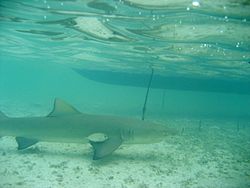Difference between revisions of "AY Honors/Species Account/Negaprion brevirostris"
| (One intermediate revision by the same user not shown) | |||
| Line 6: | Line 6: | ||
| trend = unknown | | trend = unknown | ||
| image =Lemonshark.JPG | | image =Lemonshark.JPG | ||
| − | | | + | | image_width = 200px |
| + | | regnum = [[Animal]]ia | ||
| + | | phylum = [[Chordata]] | ||
| + | | classis = [[Chondrichthyes]] | ||
| + | | subclassis = [[Elasmobranchii]] | ||
| ordo = [[Carcharhiniformes]] | | ordo = [[Carcharhiniformes]] | ||
| familia = [[Carcharhinidae]] | | familia = [[Carcharhinidae]] | ||
| Line 19: | Line 23: | ||
''Hypoprion brevirostris'' <small>Poey, 1868</small> | ''Hypoprion brevirostris'' <small>Poey, 1868</small> | ||
}} | }} | ||
| − | The '''lemon shark''', ''Negaprion brevirostris'', is a [[shark]] in the family [[Carcharhinidae]], can grow to {{convert|10|ft|m}} long.<ref>[http://www.sharksurvivor.com/sharks/lemonshark.htm Lemon Shark] - SharkSurvivor.com</ref> It is known as the lemon shark because light interacting at certain depths with the local seawater can give this shark a tanned and yellow, pitted appearance, much like the surface of a lemon. | + | The '''yellow lemon shark''', ''Negaprion brevirostris'', is a [[shark]] in the family [[Carcharhinidae]], can grow to {{convert|10|ft|m}} long.<ref>[http://www.sharksurvivor.com/sharks/lemonshark.htm Lemon Shark] - SharkSurvivor.com</ref> It is known as the lemon shark because light interacting at certain depths with the local seawater can give this shark a tanned and yellow, pitted appearance, much like the surface of a lemon. |
==Description== | ==Description== | ||
Revision as of 15:10, 7 February 2013
Template:Taxobox The yellow lemon shark, Negaprion brevirostris, is a shark in the family Carcharhinidae, can grow to Template:Convert long.& It is known as the lemon shark because light interacting at certain depths with the local seawater can give this shark a tanned and yellow, pitted appearance, much like the surface of a lemon.
Description
The lemon shark commonly attains a length of Template:Convert and a weight of up to Template:Convert at adulthood, although sexual maturity is attained at Template:Convert in males and Template:Convert in females.& The maximum recorded length and weight is Template:Convert and Template:Convert.& This stocky, powerful shark is named for its pale yellow-brown to grey skin, which lacks any distinctive markings. This provides perfect camouflage when swimming over the sandy seafloor in its coastal habitat.& It has a flattened head with a short, broad snout, and the second dorsal fin is almost as large as the first.&
Distribution and habitat
The lemon shark is found mainly along the subtropical and tropical parts of the Atlantic and Pacific coasts of North and South America, and around Pacific islands. The longest lemon shark recorded was Template:Convert long, but they are usually Template:Convert. They inhabit mostly tropical waters, stay at moderate depths, and are often accompanied by remoras.
Reproduction
Lemon sharks are viviparous, females giving birth to between four and 17 young every other year in warm and shallow lagoons. The young have to fend for themselves from birth, and remain in shallow water near mangroves until they grow larger. With increasing size, they venture further away from their birthplaces. At maturity, at a size of 1.5–2 m and an age of 12–15 years, they leave shallow water and move into deeper waters offshore. However, little is known of this life stage.
Recent work in genetics by Kevin Feldheim and Samuel Gruber may suggest adult sharks travel hundreds of kilometers to mate. Another possibility is that populations far apart may have been separated in recent times. Further research is needed for an understanding of the lemon shark's breeding behavior and ecology.
Importance to humans

Lemon sharks are a popular choice for study by scientists, as they survive well in captivity, unlike many other species, such as the great white, which die in captivity because of food refusal. The species is the best known of all sharks in terms of behavior and ecology, mainly because of the work of Samuel Gruber at the University of Miami, who has been studying the lemon shark both in the field and in the laboratory since 1967. The population around the Bimini Islands in the western Bahamas, where Gruber's Bimini Biological Field Station is situated, is probably the best known of all shark populations. As of 2007, this population is experiencing a severe decline and may disappear altogether as a result of destruction of the mangroves for construction of a golf resort. Of the 22 known lemon shark attacks since 1580, none has resulted in death.
Electroreceptors
All sharks have electroreceptors concentrated in their heads, called the ampullae of Lorenzini. These receptors detect electrical pulses emitted by potential prey. Lemon sharks are bottom dwellers. They have very poor eyesight and cannot see well to find their food, but are equipped with extremely sensitive and accurate electroreceptors in the nose.
See also
References
- ↑ Lemon Shark - SharkSurvivor.com
- ↑ [1]
- ↑ Negaprion brevirostris, Lemon shark - FishBase
- ↑ 3.Carwardine, M. and Watterson, K. (2002) The Shark Watcher’s Handbook. BBC Worldwide Ltd, London.
- ↑ 2.Compagno, L.J.V. (1984) FAO Species Catalogue. Vol 4: Sharks of the World. An annotated and illustrated catalogue of shark species known to date. Part 2: Carcharhiniformes. Food and Agricultural Organization of the United Nations, Rome. It can vary in color from a sandy yellow to a brownish yellow, depending on location. It also has poor eyesight but amazing senses to help in hunting.
- Template:ITIS
- Template:FishBase species
- Washington Post, 2005, Aug. 22nd: "Scientists Fear Oceans on the Cusp Of a Wave of Marine Extinctions"
External links
Template:Wikispecies Template:Commons
Template:Selachimorpha Template:Link GA
bg:Лимонова акула bn:লেমন শার্ক ca:Tauró llimona cs:Žralok citronový de:Zitronenhai el:Κίτρινος καρχαρίας es:Negaprion brevirostris fr:Requin-citron ko:레몬상어 it:Negaprion brevirostris hu:Citromcápa nl:Citroenhaai ja:ニシレモンザメ no:Sitronhai pnb:نمبو شارک pt:Tubarão-limão ru:Лимонная акула simple:Lemon shark sk:Žralok citrónový fi:Sitruunahai sv:Citronhaj tr:Limon köpek balığı
